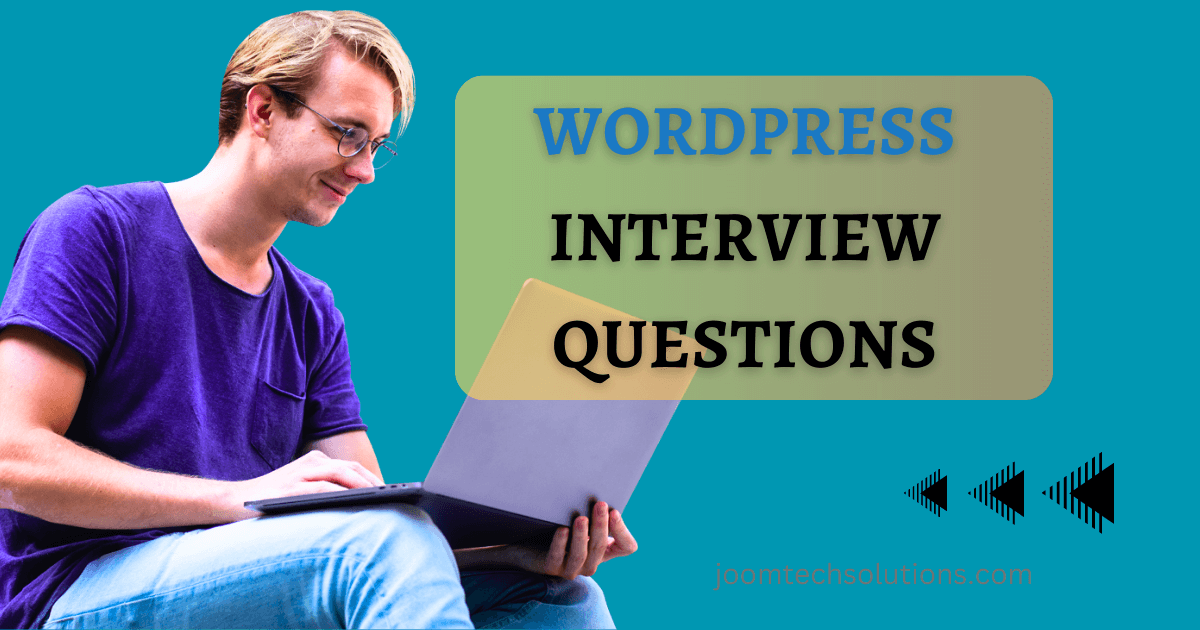During a WordPress interview, the interviewer may ask a range of WordPress interview questions to evaluate the candidate’s proficiency in various aspects of WordPress, such as installation, theme development, plugin customization, security measures, performance optimization, and troubleshooting.
A WordPress interview typically refers to an interview conducted by an employer or recruiter to assess a candidate’s knowledge, skills, and experience related to WordPress. It is commonly used for positions such as WordPress developer, WordPress designer, or any role that involves working with WordPress as a content management system (CMS).
WordPress Interview Questions and Answers
Certainly! Here are the questions you asked, along with their answers:
Q.1: What is WordPress and how does it work?
Answer: WordPress is a popular content management system (CMS) that allows users to create and manage websites. It uses a combination of a database, a set of files, and a web server to function. Users can create and edit content through a user-friendly interface, and WordPress handles the storage, retrieval, and display of that content on the website.
Q.2: What is the difference between WordPress.com and WordPress.org?
Answer: WordPress.com is a hosted platform where users can create and manage websites without worrying about hosting or technical details. WordPress.org, on the other hand, provides WordPress software that you can download and install on your web hosting server. It offers more flexibility and control over your website but requires technical setup and maintenance.
Q.3: How do you install WordPress on a web server?
Answer: To install WordPress on a web server, you can follow these general steps:
Download the latest version of WordPress from wordpress.org.
Create a database and a database user on your web server.
Upload the WordPress files to your web server using FTP or a file manager.
Run the WordPress installation script by accessing the installation URL in your web browser.
Follow the on-screen instructions to complete the installation, providing the necessary database information.
Q.4: What is a theme in WordPress? How can you create a custom theme?
Answer: A theme in WordPress is a collection of files that control the visual appearance and layout of a website. It includes templates, stylesheets, and other assets. To create a custom theme, you can follow these steps:
Create a new folder in the “wp-content/themes” directory of your WordPress installation.
Inside the new folder, create a “style.css” file that contains the theme metadata.
Create template files (e.g., index.php, header.php, and footer.php) based on your desired layout.
Customize the template files with HTML, CSS, and PHP code as needed.
Activate the custom theme from the WordPress admin panel.
Q.5: What are plugins in WordPress, and how do you install them?
Answer: Plugins in WordPress are extensions that enhance the functionality of a website. They can add new features, modify existing functionality, or integrate with external services. To install a plugin, follow these steps:
Go to the “Plugins” section in the WordPress admin panel.
Click on “Add New.”
Search for the desired plugin using keywords or browse through featured popular, or recommended plugins.
Click “Install Now” next to the plugin you want to install.
Once installed, click on “Activate” to enable the plugin on your website.
Q.6: What are the minimum requirements to install WordPress?
Answer: The minimum requirements to install WordPress are:
PHP version 7.4 or greater
MySQL version 5.6 or greater or MariaDB version 10.1 or greater
HTTPS support (recommended)
The mod_rewrite Apache module (for pretty permalinks)
Q.7: How do you create a custom page template in WordPress?
Answer: To create a custom page template in WordPress, follow these steps:
Create a new PHP file in your theme’s folder.
Add the necessary PHP code at the beginning of the file, including the template name.
Customize the content and layout of the page using HTML, CSS, and WordPress template tags.
Upload the file to your theme’s folder.
Create a new page in the WordPress admin panel and select the custom template from the Page Attributes section.
Q.8: What are shortcodes in WordPress, and how do you use them?
Answer: Shortcodes in WordPress are placeholders that allow you to add dynamic content or functionality to posts, pages, or widgets. They are enclosed in square brackets [ ] and can be used to embed elements like galleries, videos, forms, or custom code. To use a shortcode, simply insert it into the content editor of your post or page.
Q.9: What is the difference between posts and pages in WordPress?
Answer: In WordPress, posts are typically used for regularly updated content displayed in reverse chronological order, such as blog entries. They are organized into categories and tags and often have commenting functionality. Pages, on the other hand, are used for static, timeless content like an About page or a Contact page. They are not categorized and are usually hierarchical, allowing you to create parent-child relationships.
Q.10: How can you add custom functionality to a WordPress site without modifying the core files?
Answer: To add custom functionality to a WordPress site without modifying the core files, you can use WordPress hooks and filters. Hooks allow you to add or modify code at specific points in the WordPress execution flow, while filters allow you to modify data before it is displayed. You can add your custom code to your theme’s functions.php file or create a custom plugin.
Read More: How to create a website using WordPress?
Summary:
“WordPress Interview Questions and Answers” is a valuable resource for anyone preparing for a WordPress-related interview, whether for a web developer, designer, or administrator role. It equips individuals with the necessary knowledge to showcase their expertise in WordPress and secure their desired job opportunities.

